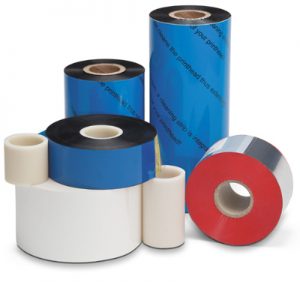A brief overview of thermal transfer ribbons – ink ribbons. Based on the amount of coloring material, ink ribbons can be divided into three main groups: WAX, WAX RESIN, and RESIN type ribbons. According to the type of printer’s print head, they are divided into two groups: FLAT – flat type head, NE – angular type head. According to the winding type – OUT – the ink side of the ribbon is on the outside, IN – the ink side of the ribbon is on the inside.
WAX ribbons. These ribbons consist mainly of wax. WAX ribbons have a lower melting temperature, so they can be printed with a lower temperature – thus putting less strain on the print head’s pores. This leads to less wear and tear on the print head.
The resistance of these ribbons to scratches, cleaning, chemical agents, and environmental factors is low. They are most commonly used for printing on matte or semi-matte uncolored labels. WAX ribbons are the cheapest.
WAX RESIN ribbons. These ribbons contain both wax and resin. Since resin has a higher melting temperature, higher printing contrast is needed during printing. The resistance of these ribbons to scratches, cleaning, chemical agents, and environmental factors is much higher than that of WAX ribbons. They are most commonly used for printing on glossy, semi-glossy white, or colored labels. WAX RESIN ribbons are slightly more expensive than WAX ribbons.
RESIN ribbons. These ribbons consist mostly of resin. Printing with them requires a much higher contrast to achieve sufficient print clarity. Also, as a consequence or trade-off for clarity, the printing speed needs to be significantly reduced. The resistance of RESIN ribbons to scratches, cleaning, chemical agents, and environmental factors is very high. These types of ribbons are most commonly used for printing on glossy labels and PP, PE film, as well as on textile labels. RESIN ribbons are the most expensive ribbons.

